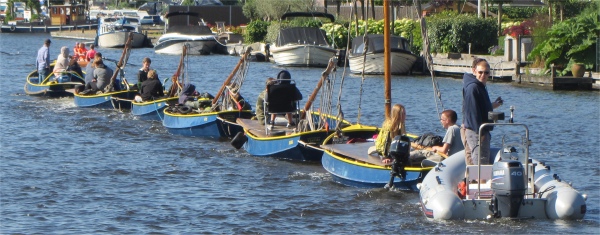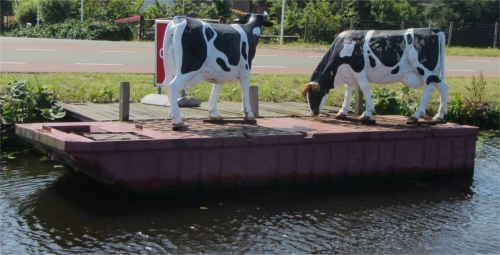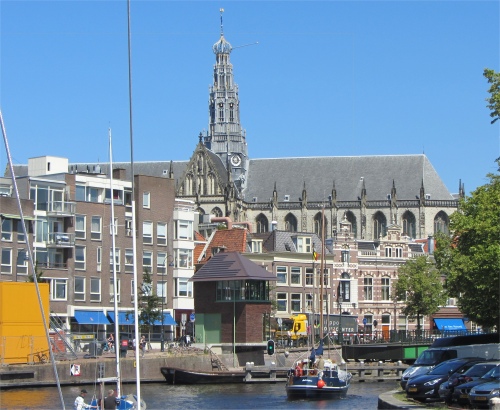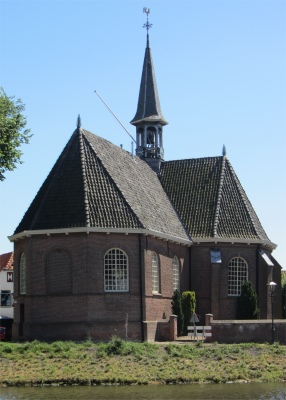 Sailing School under Tow |
We passed through pretty towns such as Lisse, with houses lining the canal banks, and of course all with immaculately kept gardens. We negotiated a few more bridges before arriving at the Cruquiusbrug just before a waterway junction, the junction being guarded by the Museum de Cruquius, once an old pumping station.
 Are These Guys Waiting for a Ferry? |
We had been travelling in a convoy of multinational vessels, and this convoy was to be maintained as we traversed the city of Haarlem. Ten bridges had to be negotiated along the way, each involving gilling about for a wee while, though the rail bridge took appreciably longer. Rex was slowly but surely getting wound up by these tedious obstacles, though I quite liked the delays since it allowed us time to admire the attractive city from the waterway.
 Wonder if There is Rising Damp in the Basement |
 Grote Kerk in Haarlem |
The Haarlemsche Jachtclub on the northern extremes of Haarlem seemed too remote, a very long hike through fields would be required to reach civilisation, besides we scraped a mud bank in the shallow waters near it. Thus we headed up a short distance to Spaarndam. Here I located the old harbour master in the equally old antique looking chandlery which he ran. He could have stepped straight out of a Dickens' novel. He was a taciturn chap, but I eventually gleaned where we were allowed to moor, and where the facilities were. This was indeed a very laid back marina.
Spaarndam is a very small town, the old port centred around the Ijdijk where the sluis and other locks all converged.
I took a stroll around the waterfront along the Pol, then around the back of Fort Zuiden Spaarndam. The fort, built in the period 1882-1903, forms part of the Defence Line of Amsterdam. There is only a narrow strip of land that could be flooded between the Spaarne and the sand dunes to the west, so this fort and one to the north acted as a line of defence against potential attacks on Amsterdam. The fort has been restored and houses a gallery and a café.
 Waag on Left and Teylers Museum on Right |
I strolled past the one and only bus stop and the church as I crossed the Ijdijk, and came across a statue. Spaarndam has always been strongly connected to water, and it is now also famous because of a story within the American novel written by Mary Mapes Dodge and first published in 1865, "Hans Brinker or the Silver Skates". The novel takes place in the Netherlands and is a colourful fictional portrait of early 19th century Dutch life, as well as a tale of youthful honour. The story within the book is about a Dutch boy, "The Hero of Haarlem," who stuck his finger in a dyke to prevent the town from flooding. The story became a popular legend in America, and in 1950 the local tourist bureau put a statue of this character in Spaarndam. A short distance further on I came to the main lock. Here I paused a while and watched a large barge lining itself up to enter the lock. In front of it was a small motor boat displaying the Red Ensign. It tootled into the lock with all the time in the world. However, the lady lock-keeper was singularly unimpressed, and came out to spur the motor boat on. The barge followed the craft in menacingly, followed in turn by a couple of more boats.
 Fort Zuiden Spaarndam |
 Spaarndam Church |
 The Hero of Haarlem - Finger in the Dyke |
I returned back along the Ijdijk via a different route, passing a pretty square in front of a small harbour. Meryl had prepared a delicious chicken salad for our evening meal, and very welcome it was too.
In the evening all three of us retraced my steps. Meryl acquired Citronelle candles at the supermarket, to aid out battle against the mosquitos; she was really getting into the swing of things regarding the little brutes. To prepare for the onslaught, we stopped off at the Cafe de Toerist for a beer; a very popular restaurant it was too.
